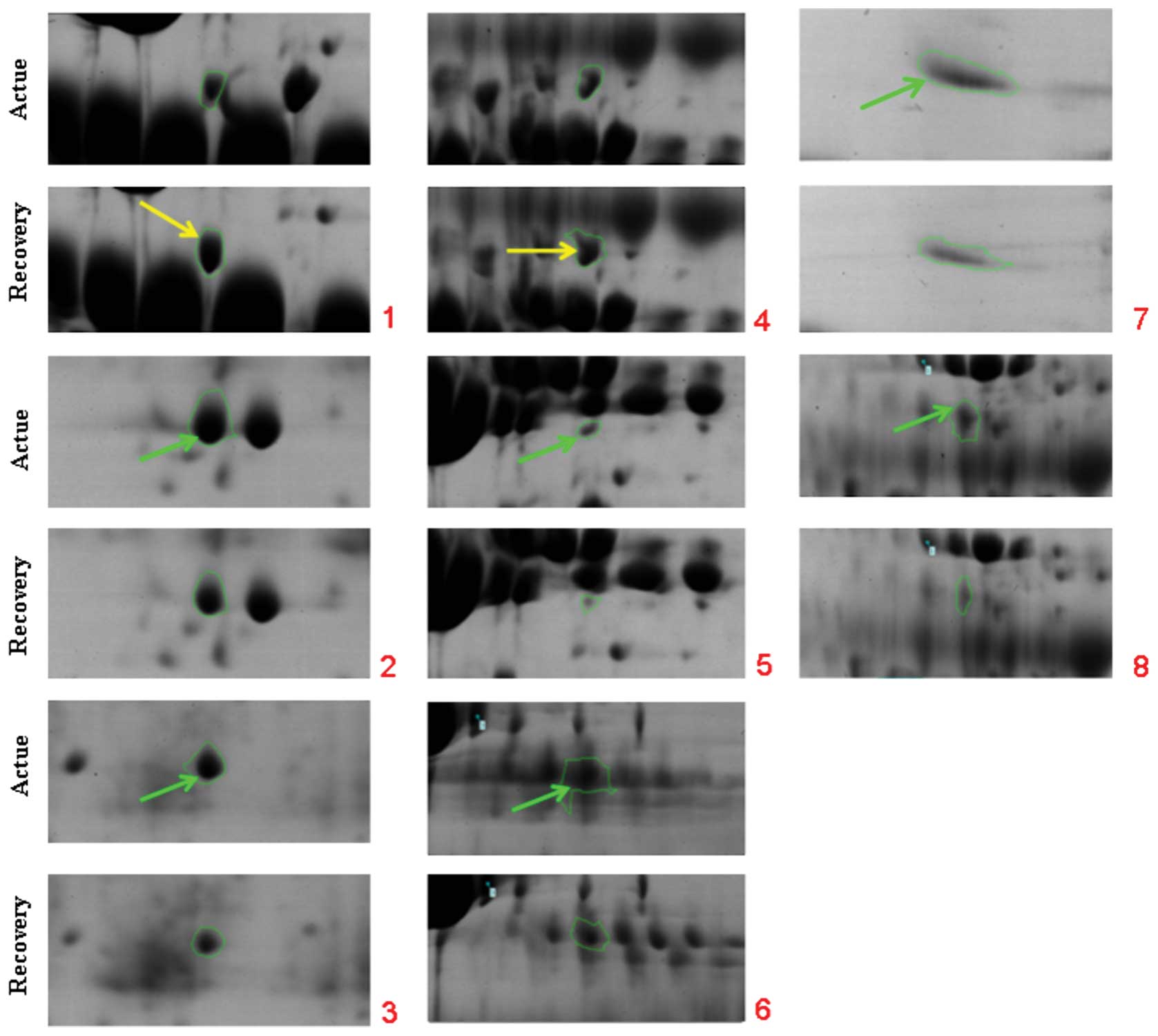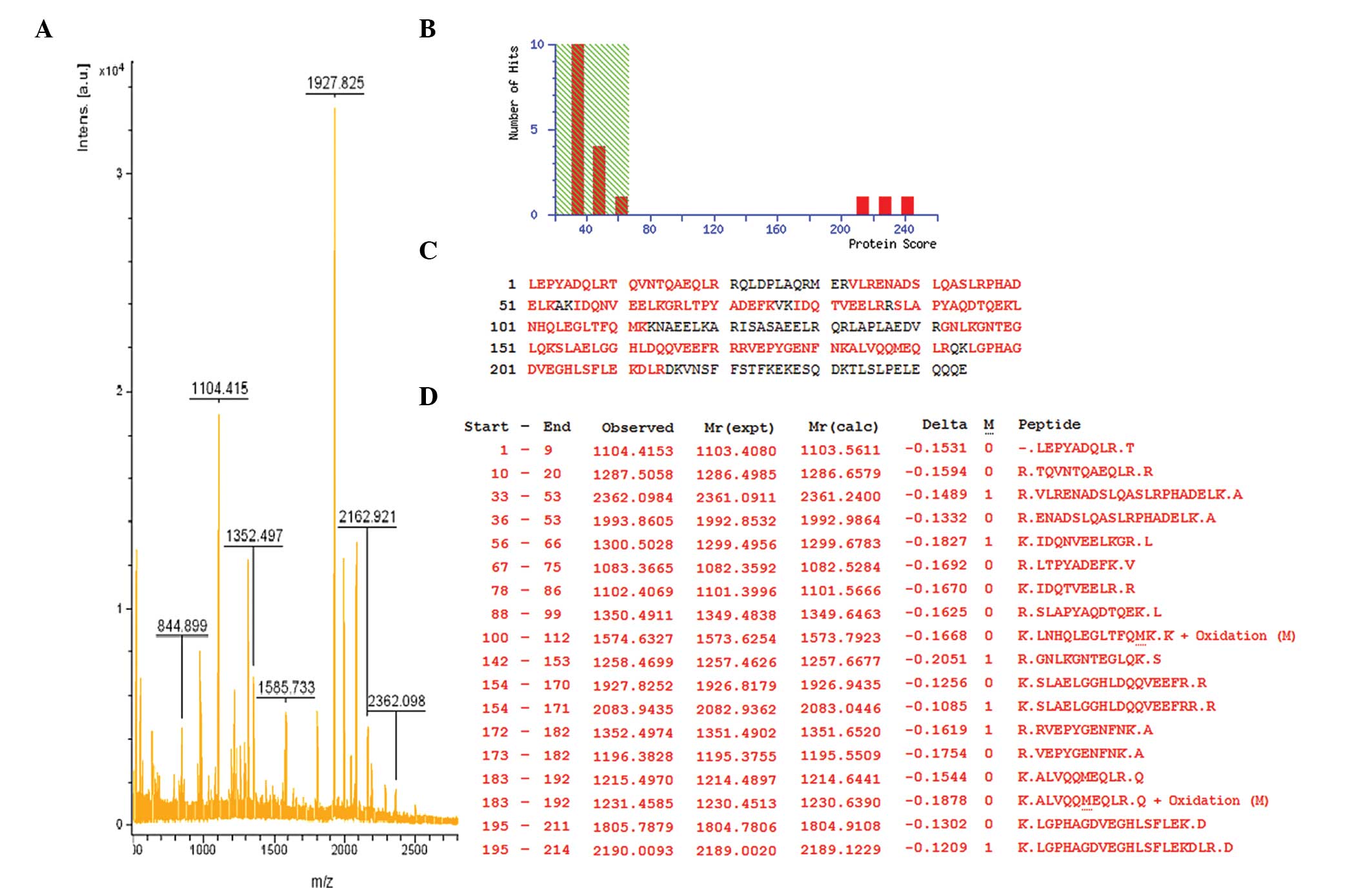|
1
|
Hackett PH and Roach RC: High-altitude
illness. N Engl J Med. 345:107–114. 2001. View Article : Google Scholar : PubMed/NCBI
|
|
2
|
Basnyat B and Murdoch DR: High-altitude
illness. Lancet. 361:1967–1974. 2003. View Article : Google Scholar
|
|
3
|
Mortimer H, Patel S and Peacock AJ: The
genetic basis of high-altitude pulmonary oedema. Pharmacol Ther.
101:183–192. 2004. View Article : Google Scholar : PubMed/NCBI
|
|
4
|
Bärtsch P, Mairbäurl H, Maggiorini M and
Swenson ER: Physiological aspects of high-altitude pulmonary edema.
J Appl Physiol. 98:1101–1110. 2005.
|
|
5
|
Maggiorini M, Mélot C, Pierre S, et al:
High altitude pulmonary edema is initially caused by an increase in
capillary pressure. Circulation. 103:2078–2083. 2001. View Article : Google Scholar : PubMed/NCBI
|
|
6
|
Schoene RB, Hackett PH, Henderson WR, et
al: High-altitude pulmonary edema. Characteristics of lung lavage
fluid. JAMA. 256:63–69. 1986. View Article : Google Scholar : PubMed/NCBI
|
|
7
|
Schoene RB, Swenson ER, Pizzo CJ, et al:
The lung at high altitude: bronchoalveolar lavage in acute mountain
sickness and pulmonary edema. J Appl Physiol. 64:2605–2613.
1988.PubMed/NCBI
|
|
8
|
Kubo K, Hanaoka M, Yamaguchi S, et al:
Cytokines in bronchoalveolar lavage fluid in patients with high
altitude pulmonary edema at moderate altitude in Japan. Thorax.
51:739–742. 1996. View Article : Google Scholar : PubMed/NCBI
|
|
9
|
Kubo K, Hanaoka M, Hayano T, et al:
Inflammatory cytokines in BAL fluid and pulmonary hemodynamics in
high-altitude pulmonary edema. Respir Physiol. 111:301–310. 1998.
View Article : Google Scholar : PubMed/NCBI
|
|
10
|
Ran YH, Zhang DX, Xiao ZH, et al: Changes
of VEGF, TNF-alpha, IL-6 and NO in serum of patients with HAPE.
Zhongguo Ying Yong Sheng Li Xue Za Zhi. 27:201–203. 2011.(In
Chinese).
|
|
11
|
Pavlicek V, Marti HH, Grad S, et al:
Effects of hypobaric hypoxia on vascular endothelial growth factor
and the acute phase response in subjects who are susceptible to
high-altitude pulmonary oedema. Eur J Appl Physiol. 81:497–503.
2000. View Article : Google Scholar : PubMed/NCBI
|
|
12
|
Yang X, Xie Y and Zhang D: Research on the
relationship between expression of VEGF and high altitude pulmonary
edema. Zhonghua Yi Xue Za Zhi. 80:931–935. 2000.(In Chinese).
|
|
13
|
Droma Y, Hayano T, Takabayashi Y, et al:
Endothelin-1 and interleukin-8 in high altitude pulmonary oedema.
Eur Respir J. 9:1947–1949. 1996. View Article : Google Scholar : PubMed/NCBI
|
|
14
|
Honda K, Ono M, Shitashige M, et al:
Proteomic approaches to the discovery of cancer biomarkers for
early detection and personalized medicine. Jpn J Clin Oncol.
43:103–109. 2013. View Article : Google Scholar : PubMed/NCBI
|
|
15
|
Penque D: Two-dimensional gel
electrophoresis and mass spectrometry for biomarker discovery.
Proteomics Clin Appl. 3:155–172. 2009. View Article : Google Scholar
|
|
16
|
Zhang YY, Duan RF and Wang H: The study of
plasma proteomic changes in a patient with high-altitude cerebral
edema. Zhongguo Ying Yong Sheng Li Xue Za Zhi. 27:180–184. 2011.(In
Chinese).
|
|
17
|
Luo Y, Zhu J and Gao Y: Metabolomic
analysis of the plasma of patients with high-altitude pulmonary
edema (HAPE) using 1H NMR. Mol Biosyst. 8:1783–1788. 2012.
View Article : Google Scholar : PubMed/NCBI
|
|
18
|
Roach RC, Bartsch P, Hackett PH and Oelz
O: The Lake Louise acute mountain sickness scoring system. Hypoxia
and Molecular Medicine. Sutton JR, Houston CS and Coates G:
Burlington, VT: Queens City Printers; pp. 272–274. 1993
|
|
19
|
Hulmes JD, Bethea D, Ho K, et al: An
investigation of plasma collection, stabilization, and storage
procedures for proteomic analysis of clinical samples. Clin
Proteomics J. 1:17–31. 2004. View Article : Google Scholar
|
|
20
|
Candiano G, Bruschi M, Musante L, et al:
Blue silver: a very sensitive colloidal Coomassie G-250 staining
for proteome analysis. Electrophoresis. 25:1327–1333. 2004.
View Article : Google Scholar : PubMed/NCBI
|
|
21
|
Görg A, Obermaier C, Boguth G, et al: The
current state of two-dimensional electrophoresis with immobilized
pH gradients. Electrophoresis. 21:1037–1053. 2000.
|
|
22
|
Yang X, Clifton J, Huang F, et al:
Proteomic analysis for process development and control of
therapeutic protein separation from human plasma. Electrophoresis.
30:1185–1193. 2009. View Article : Google Scholar : PubMed/NCBI
|
|
23
|
Anderson NL and Anderson NG: The human
plasma proteome: history, character, and diagnostic prospects. Mol
Cell Proteomics. 1:845–867. 2002. View Article : Google Scholar : PubMed/NCBI
|
|
24
|
Ren Y, Cui F, Lei Y, et al: High-altitude
pulmonary edema is associated with coagulation and fibrinolytic
abnormalities. Am J Med Sci. 344:186–189. 2012. View Article : Google Scholar : PubMed/NCBI
|
|
25
|
Ahmad Y, Shukla D, Garg I, et al:
Identification of haptoglobin and apolipoprotein A-I as biomarkers
for high altitude pulmonary edema. Funct Integr Genomics.
11:407–417. 2011. View Article : Google Scholar : PubMed/NCBI
|
|
26
|
Garber DW, Handattu SP, Datta G, et al:
Atherosclerosis and vascular disease: effects of peptide mimetics
of apolipoproteins. Curr Pharm Biotechnol. 7:235–240. 2006.
View Article : Google Scholar : PubMed/NCBI
|
|
27
|
Ma J, Liao XL, Lou B and Wu MP: Role of
apolipoprotein A-I in protecting against endotoxin toxicity. Acta
Biochim Biophys Sin (Shanghai). 36:419–424. 2004. View Article : Google Scholar : PubMed/NCBI
|
|
28
|
Yan YJ, Li Y, Lou B and Wu MP: Beneficial
effects of ApoA-I on LPS-induced acute lung injury and endotoxemia
in mice. Life Sci. 79:210–215. 2006. View Article : Google Scholar : PubMed/NCBI
|
|
29
|
Liao XL, Lou B, Ma J and Wu MP:
Neutrophils activation can be diminished by apolipoprotein A-I.
Life Sci. 77:325–335. 2005. View Article : Google Scholar : PubMed/NCBI
|
|
30
|
Li Y, Dong JB and Wu MP: Human ApoA-I
overexpression diminishes LPS-induced systemic inflammation and
multiple organ damage in mice. Eur J Pharm. 590:417–422. 2008.
View Article : Google Scholar : PubMed/NCBI
|
|
31
|
Bates SR, Tao JQ, Collins HL, Francone OL
and Rothblat GH: Pulmonary abnormalities due to ABCA1 deficiency in
mice. Am J Physiol Lung Cell Mol Physiol. 289:L980–L989. 2005.
View Article : Google Scholar : PubMed/NCBI
|
|
32
|
Yuditskaya S, Tumblin A, Hoehn GT, et al:
Proteomic identification of altered apolipoprotein patterns in
pulmonary hypertension and vasculopathy of sickle cell disease.
Blood. 113:1122–1128. 2009. View Article : Google Scholar : PubMed/NCBI
|
|
33
|
Wang W, Xu H, Shi Y, et al: Genetic
deletion of apolipoprotein A-I increases airway
hyperresponsiveness, inflammation, and collagen deposition in the
lung. J Lipid Res. 51:2560–2570. 2010. View Article : Google Scholar : PubMed/NCBI
|
|
34
|
Kim TH, Lee YH, Kim KH, et al: Role of
lung apolipoprotein A-I in idiopathic pulmonary fibrosis:
antiinflammatory and antifibrotic effect on experimental lung
injury and fibrosis. Am J Respir Crit Care Med. 182:633–642. 2010.
View Article : Google Scholar : PubMed/NCBI
|
|
35
|
Weng XQ, Huang LY, Lin WT, et al: Effect
of intermittent hypoxic exercise on blood-lipid and Apo of rat.
China Sport Science. 25(9): 46–48. 2005.(In Chinese).
|
|
36
|
Weinberg RB: Apolipoprotein A-IV
polymorphisms and diet-gene interactions. Curr Opin Lipidol.
13:125–134. 2002. View Article : Google Scholar : PubMed/NCBI
|
|
37
|
Fujimoto K, Cardelli JA and Tso P:
Increased apolipoprotein A-IV in rat mesenteric lymph after lipid
meal acts as a physiological signal for satiation. Am J Physiol.
262(6 Pt 1): G1002–1006. 1992.PubMed/NCBI
|
|
38
|
Tso P and Liu M: Apolipoprotein A-IV, food
intake, and obesity. Physiol Behav. 83:631–643. 2004. View Article : Google Scholar : PubMed/NCBI
|
|
39
|
Li J, Song M, Qian D, et al: Decreased
plasma apolipoprotein A-IV levels in patients with acute coronary
syndrome. Clin Invest Med. 36:E207–E215. 2013.PubMed/NCBI
|
|
40
|
Guo Q, Li QY, Wang Y, et al: Research on
apo A-IV of obstructive sleep apnea-hypopnea syndrome. Int J
Respir. 31:1149–1152. 2011.(In Chinese).
|













